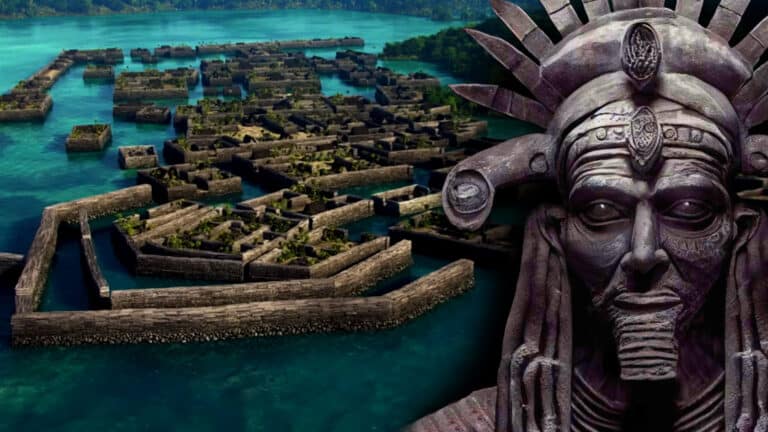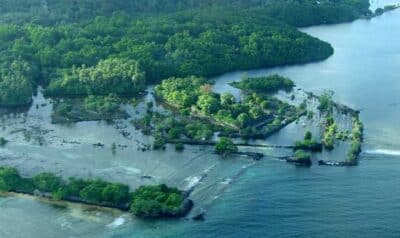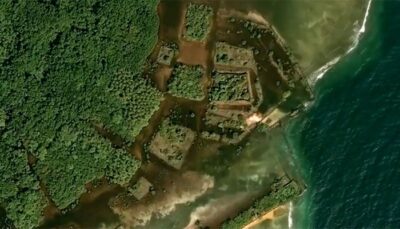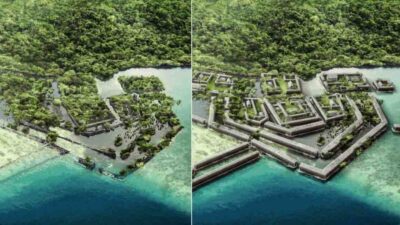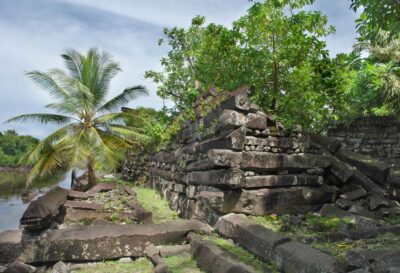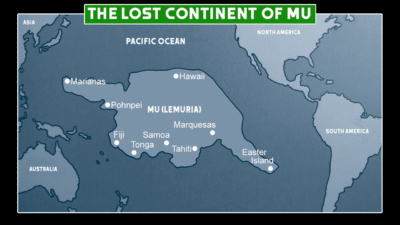All around the world, ancient megalithic sites challenge our perception of human history. From Stonehenge to the pyramids of Egypt, to Adam’s Calendar and Gunung Padang, and beyond, these sites force us to rethink what our forefathers were capable of, and whether the facts contained in our history books might not tell the whole story of our past.
In the middle of the vast expanse of the Pacific Ocean in Micronesia, there lies a megalithic site as baffling and mysterious as any on earth, a site which has been a breeding ground of legends and secrets for centuries.
And yet, despite its status as one of the most incredible ancient sites in the world, most people have probably never heard the name – Nan Madol.
There is perhaps a good reason for this …
Pohnpei, Micronesia - Home To Nan Madol
The Micronesian island of Pohnpei is truly in the middle of nowhere. Off its shores to the east lie more than 5,000 miles of open ocean until you hit California, while to the west, another 2,500 miles of ocean to Manila in the Philippines.
The island itself is small and mostly insignificant, a mere 13 miles of inhospitable terrain from end to end, covered in thick jungles and mangrove swamps, with a steep mountain rising in the middle. Yet, despite its remote location and inhospitable terrain, Pohnpei is home to the remains of a megalithic structure on an unfathomable scale in Micronesia.
In the shallow waters off its eastern shores stands a massive stone complex – 92 artificial islets built on top of a coral reef over an area a mile long, all linked by an elaborate network of stone-lined canals. These stone canals give the place its name – Nan Madol, which translates to “within the intervals.”
In more modern times, Nan Madol has been given another name – “The Venice of the Pacific.” It is not hard to see why.
Throughout the complex are a series of unbelievable structures made from enormous basalt stones – walls standing as high as 58 feet tall and measuring as much as 17 feet thick, columns and buildings, all made from stones which weigh anywhere from 5 to 50 tons, stacked in the manner which one might construct a log cabin. Astonishingly, it has been estimated that over 750,000 tons of stone were used in the site’s construction. As David Childress, who conducted several investigations at Nan Madol in the 1980s and 90s, put it,
“The whole project is of such huge scale that it easily compares with the building of the Great Wall of China and the Great Pyramid of Egypt in sheer amounts of stone and labor used, and the gigantic scope of the site.”
Simply, Nan Madol is without a doubt one of the most astonishing megalithic sites anywhere on earth, and in fact, the only one ever built atop a coral reef. But who could have built such a thing?
Who Built Nan Madol and When Was it Built?
In modern times, carbon dating conducted on the stone megaliths at the site suggest that Nan Madol’s construction began around 1180 AD, leading to the conclusion that Nan Madol was built by the Saudeleur dynasty which ruled the island of Pohnpei at that time. According to this theory, when the Saudelers were overthrown in the 1600s, the site was abandoned, leaving the mysterious ruins which remain to this day.
And yet, additional studies done at the site indicate that the earliest settlement there goes back well beyond 1180 AD, to the 2nd century BC, or maybe even beyond.
Perhaps the mystery of Nan Madol goes many years beyond the Saudeleur dynasty …
If Nan Madol was built 1000 years ago by the Saudeleur dynasty, a simple question arises – how did they do it?
Firstly, no stone quarries exist in the immediate vicinity of the site, meaning the enormous basalt stones which make up Nan Madol must have been transported there from elsewhere.
But how? The island of Pohnpei is too rugged to get stones across, meaning that whether Nan Madol’s builders got the stones from the island or another small island somewhere else in the area, they would have had to float them across the ocean to the site.
Initially, some proposed that they could have done this using bamboo rafts, a theory which was quickly invalidated when the sheer weight of the stones used in Nan Madol was considered. In fact, in 1995, a Discovery Channel special on Nan Madol tried using bamboo rafts to float stones weighing 1-2 tons, only a fraction of the size of those used in the site’s construction, but found that the rafts quickly sunk.
But say, for the sake of argument, that Nan Madol’s builders were able to get the huge basalt stones to the site, whether with rafts or by another unknown method. This still does not explain how the stones were lifted and stacked into buildings and walls and canals by people who did not even have pulleys or levers or other modern technological advancements.
Even today, to lift a 50-ton stone is a great undertaking, requiring a powerful crane and an experienced crew. So how could a population hundreds of years in the past without such a crane, or even basic instruments of leverage, have accomplished it?
But again, even if the Saudeleurs were able to transport the huge stones to Nan Madol somehow, then lift and place them without pulleys or levers, this still leaves a hole in the explanation.
At the time of the Saudeleur dynasty, the population of the entire island of Pohnpei is estimated to have been between 20,000 and 30,000 people, including children and the elderly. Simply, this population doesn’t line up with the labor required to complete a project like Nan Madol. The desolate island could barely support the day-to-day lives of its inhabitants, let alone an undertaking like the building of Nan Madol. Some have estimated that given Pohnpei’s population and the number of working-age people on the island, Nan Madol’s creation would have taken more than three centuries.
What all of this means is simple. Though scientists believe Nan Madol was built by the Saudeleur dynasty around 800 years ago, they actually have no idea how it was built.
To answer that question, we may have to look somewhere else …
The Legend of Nan Madol's Construction
According to the oral history of the Pohnpeian people, Nan Madol has a very specific origin.
It begins with the story of a group of seven men and nine women who set out from somewhere across the ocean looking for a new home sometime in the distant past. During their journey, they met an octopus spirit, who directed them to an unknown island in the Pacific Ocean. But it was a trick, and when they arrived, the island was no bigger than a canoe, nowhere near large enough to settle on. Luckily, the travelers possessed magic powers which allowed them to call the rest of the island above the water, and there they settled, building a stone altar in the middle and naming the island Pohnpei, which meant, “upon a stone altar.”
Over centuries, five more groups of settlers would arrive on the island, each bringing secret magical knowledge of how to move mountains, raise reefs, and shape the island, building, over time, a flourishing civilization.
Eventually, a 7th group arrived, bringing the “mightiest sorcerers yet,” the brothers Olosihpa and Olosohpa. It was these brothers who built Nan Madol by using their magic powers to fly huge basalt stones through the air as if they were weightless, and stacking them into islets, canals, walls, and buildings. So powerful was their magic, that the brothers conquered Pohnpei, founding what came to be known as the Saudeleur dynasty.
In some ways, this oral history fills in the story of the island of Pohnpei back to a time before history was written, a tale of conquest, civilization building, and dynastic rule, explained through a dramatic myth. But look closer at the story, and specifically the ability of the brothers Olosihpa and Olosohpa to levitate huge stones weighing up to 50 tons through the air using some sort of magic. Some have suggested that this was not magic, and that the story was not myth at all, but rather, “the folk memory of a lost technology.”
But what type of lost technology could have allowed an ancient people to levitate enormously heavy stones through the air?
If you have watched our YouTube channel before, you probably already know the answer. It is called acoustic levitation, described as a method of raising heavy stones by matching the sound frequency of matter, making it weightless and moving it into place.
Consider the ancient megalithic sites around the world built from huge stones which would seemingly have been impossible for the ancients to have moved, let alone used for construction – from Stonehenge to the Great Pyramid of Giza, and many, many others. According to some, the existence of these megalithic sites suggests that the ancients have mastered the art of levitation, through sonics or some other method, that allowed them to defy gravity and move massive objects easily.
Adding to the intrigue is the fact that, in almost every culture where megalithic structures exist, there’s some kind of legend that says the huge stones were moved by acoustic means—either by secret songs, or by massive gongs, trumpets, lyres, or cymbals.
If you want to know more about the secrets of acoustic levitation, make sure to watch our video exploring the subject in detail.
But could acoustic levitation have been utilized at Nan Madol? Might it be the secret behind an ancient people moving and stacking stones of many tons, recorded in local history as two brothers with magic powers?
Perhaps. Or perhaps there is another explanation for Nan Madol which is even more incredible…
The Curse of Nan Madol
For centuries, Pohnpeian tradition has warned of the terrible powers associated with Nan Madol. Locals believe that the site is looked after by spirits placed there by the ancients to protect it from outsiders, and that anyone who disturbs the site will be cursed.
Maybe this is just a myth enacted by locals to discourage colonial powers from damaging their history. But what if it isn’t?
Outsiders from Europe first reached the island of Pohnpei in the early-1800s, whereupon they immediately took note of the ruins at Nan Madol. One of the earliest to do so was the surgeon of a trading ship named Dr. Campbell, who eloquently recorded the site in an 1836 paper titled Island of Ascension. In his words, Nan Madol was
“…the work of a race of men far surpassing the present generation, over whose memory many ages have rolled, and whose history oblivion has shaded forever, whose greatness and whose power can only now be traced from the scattered remains of the structures they have reared, which now wave with evergreens over the ashes of their departed glory, leaving to posterity the pleasure of speculation and conjecture.”
For decades, that’s all European knowledge about Nan Madol amounted to – speculation and conjecture – until the 1870s, when a Polish anthropologist named Johann Kubary arrived at Pohnpei in the midst of an historic journey.
Kubary had taken a job with a trading company in 1869 which sent him across the world to the Pacific Islands. There, he visited the islands of Samoa, Palau, Ebon, Jaluit, and others, gathering never-before-seen samples and earning a reputation as one of the greatest collectors on earth.
In 1873, he arrived at the island of Pohnpei, where he would undertake the first systematic exploration and description of the ruins at Nan Madol, no longer gazing from afar, as Europeans before him had, but diving into the site as an anthropologist in an attempt to discover the site’s secrets.
Despite vigorous warnings from locals about Nan Madol’s curse, Kubary collected numerous ornaments and implements at the site, and even discovered unexplored crypts which he named “The Royal Tombs.” As he recorded in his work,
“All the tombs we explored were filled with coral. Everywhere we found remnants of human bones and very primitive ornaments (bracelets and necklaces), implements (stone axes), and so on. The shells of a Spondylus species, pierced at the hinge and used as chest ornaments, were strongly represented. They were put in great numbers with the dead in the tomb, and they appear to have been a special testimony to the piety of the natives.
We have also found round discs in the tombs, pierced in the middle, so highly valued today, which serve as money and to adorn the waistband and the headband. The presence in the same vault of many lower jaws and frontal bones indicates family burials, and the number of the particularly noteworthy tombs which contain bones being limited to 13, we conclude that they were exclusively tombs of kings or chiefs.”
By 1874, Kubary was ready to return to Europe with his incredible cache of artifacts recovered at the site, but on the way, disaster struck. In the words of one trader who accompanied Kubary’s journey back to Europe, as their ship attempted to maneuver through the narrow ocean passage at Jaluit near the Marshall Islands,
“Instead of heading the vessel for the southern Arm of the passage leading to the anchorage, Becker [the captain] ran her stern on to a point of reef, which divides the main passage into the north & south arms. He blamed the bad steering of the vessel, but others put it down to his stupidity.
The ship was totally abandoned that evening and her hands took up their quarters at or near Capelle’s station. During the next day the sea got up and broke over the vessel laying with her deck to seaward. Her hatches got adrift, the cargo was washed out & then her decks blew up. At 3:30 pm the mainmast fell. Next morning the brig was completely broken up & nothing was to be seen except a confused heap of broken & twisted iron, wire rigging & some battered spars.”
Just like that, the ship was lost, and hundreds of Kubary’s crates containing much of Nan Madol’s history sunk to the bottom of the ocean, lost forever.
For Kubary, the shipwreck was devastating, but unfortunately, things would only get worse for him. In 1879, the trading company he was working for went bankrupt, leaving him without employment. He decided to stay on a plantation he had purchased in Pohnpei, where he married a local woman and had two children. Tragically, however, both children died in childhood. Then, in 1882, Kubary’s plantation was demolished when a hurricane passed over the area. The few coconut palms which were left standing, were then quickly wiped out by a plague of beetles which followed the hurricane. With nowhere else to go, Kubary slowly set about rebuilding his plantation, taking intermittent work with trading companies or museums which sent him around the Pacific Islands when he could. That was until 1895, when local Pohnpeians revolted against Spanish dominion over their island and completely destroyed Kubary’s plantation once and for all. Without hope and penniless, Kubary would commit suicide in 1896.
Was this the curse of Nan Madol at work? Had Kubary brought this terrible run of misfortune upon himself when he removed artifacts and bones from the site in 1873 and 74?
Discoveries of Giants at Nan Madol
By the early 20th century, Pohnpei had come under German rule, and the position of governor had been given to a man named Victor Berg, a mean-spirited and vicious individual who had spent much of his adult life in the Pacific Islands.
Despite being heavily warned against it by locals, Berg would begin exploring Nan Madol in 1907. Deep within the complex, he discovered a sealed tomb said to contain the remains of Pohnpei’s ancient rulers.
Shockingly, within the tomb, Berg found skeletal remains unlike those any had seen before. The bones were enormous, seemingly belonging to a race of giants some 10 feet tall. Was this even possible, Berg wondered, and if so, who were these giant ancient rulers?
The night of his discovery, as Berg tried to sleep, a wild storm rolled over the island, hammering the terrain with lightning and torrential rains. In the distance, Berg and others swore they heard the sound of conch shells echoing off Pohnpei’s mountains, while, even more bizarrely, strange glowing orbs purportedly filled the sky as the storm raged.
The next day, with the storm seemingly having passed, Berg was determined to continue his work on Nan Madol. But as he headed to the site, he suddenly stopped in his tracks, and without warning, dropped dead where he stood.
Immediately, the locals claimed that Berg’s fate had been sealed the moment he had disturbed Nan Madol. His death, and the storm which proceeded it, proof, they asserted, of the supernatural powers which guard the site.
A German physician stationed on the island had another explanation, proposing the cause of death to be sunstroke and heat exhaustion, a curious diagnosis for an otherwise healthy man like Berg who had been in the Pacific Islands for many years and was well accustomed to the heat.
Yet, how he died is perhaps not the most important question which arises from the story of Victor Berg. Whether his death resulted from sunstroke or curse, there is still the matter of what Berg discovered before he died – skeletal remains which seemed to belong to giants.
Oral history says that the brothers who built Nan Madol were sorcerers. Could they also have been giants? Could this explain how they were able to move such heavy stones?
One thing is for sure – this was not the last time giants would be connected with Nan Madol.
After World War I, control of the island of Pohnpei passed into the hands of Japan. Like those who had ruled the island before them, the Japanese also took to investigating Nan Madol. However, what they allegedly found went far beyond anything prior.
Today, the record of Japan’s rule over Pohnpei is fragmented and mostly missing, since many Japanese records from the area were lost at the outbreak of World War II. Yet, some remaining sources indicate that before the war, Japanese scientists discovered that the existing ruins of Nan Madol built atop coral reef were only a piece of the puzzle, that in fact, Nan Madol extended further out into the ocean and beneath the waves, that it was actually an entire sunken city.
It was there that the Japanese were said to have found huge platinum coffins on the ocean floor. Incredibly, when they broke up the coffins in order to bring them to the surface, they purportedly found the skeletal remains of giant humans standing 10 feet tall inside them.
Could this really be true?
What is particularly interesting about these findings, like Berg’s findings before them, is that the idea that a race of giants existed some time in the distant past is not confined to Nan Madol; in fact, it appears across human traditions.
In the Book of Genesis, for example, there is a record of a race of giants deep in the past known as the Nephilim, who were so large that in their presence humans “became like grasshoppers in our own sight, and so we were in their sight.” Even in modern times, enormous skeletons seemingly belonging to giants have been discovered all over the world – in the United States, Africa, the Amazon Rainforest, Asia, and elsewhere. Is it possible that the existence of giants sometime in the distant past could explain Nan Madol?
If it sounds impossible, you’re going to want to watch our video which brings together all of the astonishing evidence discovered in modern times which suggests that ancient giants were real and coexisted with early humans.
Then, you might want to take a look at our video on the Book of Enoch, which at one time was part of both Jewish and Christian canon before it was censored out, and tells an entirely different history of humanity than what we know today, one centered around “giants and savages that endangered and pillaged humanity.”
But maybe to find an answer to the mystery of Nan Madol, we need to move beyond the giant bones allegedly found there, and focus on the platinum coffins they were discovered in.
The fact is, platinum coffins are not the only thing which has been found off the shores of Nan Madol.
The Lost City of Nan Madol
In 1939, a German explorer and author named Herbert Rittlinger, who had visited Nan Madol during the time it was under Japanese control, wrote of what had been found there in his book The Measureless Ocean.
According to Rittlinger, the discoveries off the shores of Nan Madol in fact went far beyond platinum coffins. As he wrote, beneath the ocean was a
“…brilliant and splendid center of a celebrated kingdom that had existed there untold millennia ago. The reports of fabulous wealth had enticed pearl divers and Chinese merchants to investigate the seabed secretly and the divers had all risen from the depths with incredible tales. They had been able to walk on the bottom on well-preserved streets overgrown with mussels and coral. ‘Down below’ there were countless stone vaults, pillars and monoliths. Carved stone tablets hung on the remains of clearly recognizable houses”
What the pearl divers did not find was discovered by Japanese divers with modern equipment. They confirmed with their finds what the traditional legends of Ponpei reported: the vast wealth in precious metals, pearls and bars of silver.”
In other words, Nan Madol was only a piece of an astounding ancient city long lost beneath the ocean waves. Interestingly, this lines up with Pohnpeian legend, which speaks of “another kingdom under the ocean” off the shores of Nan Madol.
In more modern times, further evidence has emerged supporting this theory. In the 1970 and 80s, archaeologists noted an extensive network of tunnels and caves beneath Nan Madol leading out into the ocean. One team followed this network to a collection of stone pillars and structures some 100 feet under the water, speculating that it was only the start of a vast network of underwater ruins. But since then, no full-scale investigation has been undertaken to determine what might lay beneath the ocean.
Could there really be “another kingdom under the ocean,” and, if so, who built it, and where did it come from?
Some believe they already know the answer …
Was Nan Madol Part of Lemuria or Mu?
On our website, we have covered in detail the legendary lost continent of Lemuria, also known as Mu.
For the uninitiated, the idea was first introduced in the late-1800s by an archaeologist named Augustus Le Plongeon, who claimed that while working in the Yucatan Peninsula he had come across a series of ancient Mayan transcriptions which told of an ancient lost continent named Mu that had been submerged beneath the ocean sometime in the distant past.
The idea was picked up on in the 1920s and 30s by a man named James Churchward, who asserted that during his time as a soldier in British India, he had become privy to a set of ancient clay tablets which told of an ancient lost continent in the Pacific Ocean named Mu. According to Churchward, the continent, which stretched 3,000 miles from north to south and 5,000 miles from east to west, was home to an advanced ancient civilization which existed 50,000 years ago, before it suddenly sank to the bottom of the ocean and disappeared forever.
Given Pohnpei’s location in the Pacific Ocean, some believe that Nan Madol represents the outskirts of the legendary lost continent. In fact, this was proposed by Churchward himself in 1926, before platinum coffins or underground tunnels were ever discovered.
Could this really be possible? Could “another kingdom under the ocean” off the shores of Nan Madol really be the remains of an advanced ancient civilization from tens of thousands of years in the past?
Some say there is even more evidence which says yes …
Nan Madol - Ancient Weather Modification System
The island of Pohnpei, while apparently in the middle of nowhere, is in fact located at a noteworthy location on the globe, smack dab in the middle of “a 300-mile-long zone in which typhoons are born and the first stages of their power and severity are developed.”
Today, we know that typhoons are formed not only as a result of cold air currents colliding with warm ocean waters, as has long been postulated, but that they also have an electromagnetic component. Given its location, some look at the huge basalt stones of Nan Madol, which have strong electromagnetic properties, and propose that they must have been put there in order to break down the electromagnetic qualities of typhoons as they try to form, making them release their energy in the form of downpours and protecting the area. In other words, Nan Madol is not an ancient city, but some sort of intentionally constructed weather modification project.
Already, this suggests a technological capability beyond what is possible in modern times, but some have taken it even further, looking deeper into the electromagnetic properties of Nan Madol.
Nan Madol - Ancient Powerplant?
Consider that the island of Pohnpei produces consistent subtle seismic activity, which generates piezoelectricity. Some believe that when this piezoelectricity meets with the giant magnetized basalt stones laid out in canals and walls, and towers at Nan Madol, the site becomes a “power source.” As author Frank Joseph described in a book on the subject,
“Transforming the basalt’s naturally vertical magnetic field into a spiral would amplify the power of any piezoelectric discharge by swinging it around in a narrowing, tightening circuit, then focusing the beam of its concentrated corona discharge skyward.”
More simply,
“Nan Madol was never a city, certainly not in any ordinary sense of the world, but a power station undoubtedly constructed by the Pohnpeians’ ancestors”
Incredibly, this sounds not unlike the pioneering work of Nikola Tesla, who proposed something similar for his legendary Wardenclyffe Tower at the turn of the 20th century. If you have not yet heard of Tesla’s work on this subject, you’ve got to watch our video, which examines Tesla’s belief that the earth could be pumped for electricity, and how he thought it could be done. The link is also in the top right corner and in the comment section.
Could the inhabitants of Pohnpei have been working with the type of power source proposed by Tesla for thousands, or tens of thousands of years in the past? Could Nan Madol really have been an ancient power station, fueling an advanced ancient civilization?
Conclusion
One thing, at least, is clear. Even if Nan Madol is simply an 800-year-old megalith built by the Saudeleur dynasty, it stands as one of the most amazing structures on earth. But it might be so much more than that, the key to the secrets of humanity’s past, of the mythical continent of Mu and an advanced ancient civilization.

